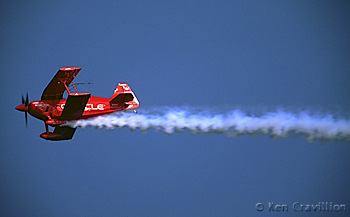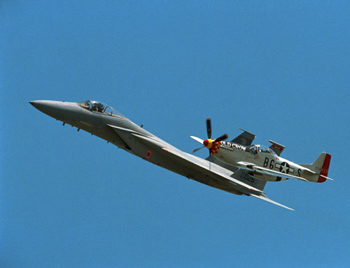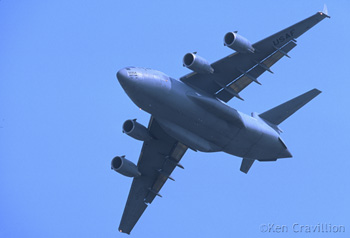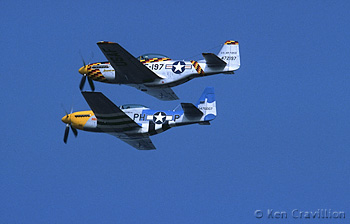![]()
Home Hit your BACK button to return to a previous page
Aviation Photography
I've always been fascinated by flight. At one time I wanted to design airplanes. I'll eventually get my pilots license (when I have time!). I am fortunate to live in Oshkosh, Wisconsin where every year we have one of the largest air shows, E.A.A. or the Experimental Aircraft Association. Over the years I have enjoyed going there to view airplanes. Seeing the latest in military hardware demonstrated. Watching little planes twirling and twisting has always been interesting. These last few years I've started capturing them on film.
This article will help you get the most from your equipment and learn a few techniques to make pleasing images.
![]()
Equipment
I personally use an EOS-1V HS which has a high frame rate and also has fast auto focus to keep up with the action. Any camera with reasonably fast AF will do. If you use a manual focus body, focusing isn't difficult as you will be focusing near infinity anyway.
Multiple focusing points also benefit the aviation photographer. Maintaining focus on an aircraft on the edge allows you to avoid the dead center "normal" shots.

Taken with an EOS-1V HS and EF 300 2.8L IS and EF 2X, Fuji Velvia
I was able to compose this image using the left most focusing point of my EOS-1V HS. The dark corners were because I was shooting wide open at f/5.6. Stopping down a bit will get rid of that.
![]()
Generally, the longer the lens the better. It depends on the size of the plane and how close you are to the runway. For most of my aviation photography I use a Canon EF 300 2.8L IS with and without a 2X converter.
Telephotos also compress distances, making groups of things seem closer to each other than they really are.

Taken with an EOS-3 and EF 300 2.8L IS and EF 2X, Fuji Superia 400
You can really see the compression from 600mm. The F-15 Eagle and P-51 Mustang appear to almost touch.
![]()
For a large plane like a C-17, around 300mm is fine. Groups of airplanes also don't need extreme lengths.

Taken with an EOS-1V HS and EF 300 2.8L IS, Fuji Provia 100F
At times that day as you can see there was some nasty atmospheric haze. Fortunately it dissipated later...
![]()
For smaller acrobatic airplanes and some military fighter jets using a 2X may be necessary if you don't have anything longer than a 300mm.

Taken with an EOS-1V HS and EF 300 2.8L IS and EF 2X, Fuji Provia 400F
Again you can see the compression effect.
![]()
Film
Use whatever film you like. These four images were all taken with different films. I used Fuji Velvia, Provia 100F, Provia 400F and Superia 400 negative film. If you plan to use Velvia, you'll probably need a fast aperture lens (f/2.8-f/4) as your shutter speed will be slower.
Technique
Metering, sometimes I use aperture priority when the light is changing. Sometimes I meter off green grass in manual mode. Both ways work fine.
Learn to pan. Planes will most likely be flying from either side and passing in front of you. Handholding is fine, if your lens isn't heavy, but almost any long telephoto with a f/2.8 or f/4 aperture (heavy) will benefit from a monopod.
Shutter speeds are important. For jets, high shutter speeds are fine. They are moving very fast. They also don't have a propeller to freeze.
Aircraft with propellers need a slower speed. If not you, will freeze that propeller and the plane will look funny floating in midair with a stationary propeller. From my experience, something in the 1/250 range is good to start with.
![]()